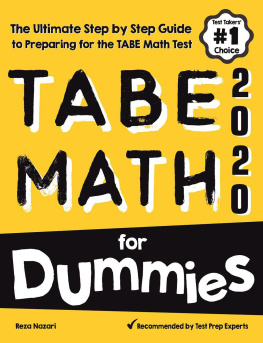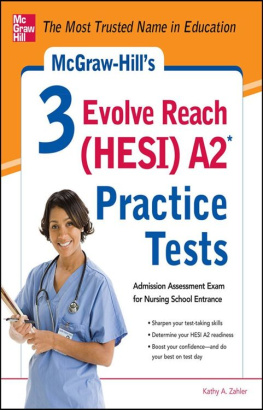
 Copyright 2006 by The McGraw-Hill Companies. All rights reserved. Except as permitted under the United States Copyright Act of 1976, no part of this publication may be reproduced or distributed in any form or by any means, or stored in a database or retrieval system, without the prior written permission of the publisher. ISBN: 978-0-07-177163-4
Copyright 2006 by The McGraw-Hill Companies. All rights reserved. Except as permitted under the United States Copyright Act of 1976, no part of this publication may be reproduced or distributed in any form or by any means, or stored in a database or retrieval system, without the prior written permission of the publisher. ISBN: 978-0-07-177163-4
MHID: 0-07-177163-8 The material in this eBook also appears in the print version of this title: ISBN: 978-0-07-144689-1, MHID: 0-07-144689-3. All trademarks are trademarks of their respective owners. Rather than put a trademark symbol after every occurrence of a trademarked name, we use names in an editorial fashion only, and to the benefit of the trademark owner, with no intention of infringement of the trademark.
Where such designations appear in this book, they have been printed with initial caps. McGraw-Hill eBooks are available at special quantity discounts to use as premiums and sales promotions, or for use in corporate training programs. To contact a representative please e-mail us at bulksales@mcgraw-hill.com. TERMS OF USE This is a copyrighted work and The McGraw-Hill Companies, Inc. (McGraw-Hill) and its licensors reserve all rights in and to the work. Use of this work is subject to these terms.
Except as permitted under the Copyright Act of 1976 and the right to store and retrieve one copy of the work, you may not decompile, disassemble, reverse engineer, reproduce, modify, create derivative works based upon, transmit, distribute, disseminate, sell, publish or sublicense the work or any part of it without McGraw-Hills prior consent. You may use the work for your own noncommercial and personal use; any other use of the work is strictly prohibited. Your right to use the work may be terminated if you fail to comply with these terms. THE WORK IS PROVIDED AS IS. McGRAW-HILL AND ITS LICENSORS MAKE NO GUARANTEES OR WARRANTIES AS TO THE ACCURACY, ADEQUACY OR COMPLETENESS OF OR RESULTS TO BE OBTAINED FROM USING THE WORK, INCLUDING ANY INFORMATION THAT CAN BE ACCESSED THROUGH THE WORK VIA HYPERLINK OR OTHERWISE, AND EXPRESSLY DISCLAIM ANY WARRANTY, EXPRESS OR IMPLIED, INCLUDING BUT NOT LIMITED TO IMPLIED WARRANTIES OF MERCHANTABILITY OR FITNESS FOR A PARTICULAR PURPOSE. McGraw-Hill and its licensors do not warrant or guarantee that the functions contained in the work will meet your requirements or that its operation will be uninterrupted or error free.
Neither McGraw-Hill nor its licensors shall be liable to you or anyone else for any inaccuracy, error or omission, regardless of cause, in the work or for any damages resulting therefrom. McGraw-Hill has no responsibility for the content of any information accessed through the work. Under no circumstances shall McGraw-Hill and/or its licensors be liable for any indirect, incidental, special, punitive, consequential or similar damages that result from the use of or inability to use the work, even if any of them has been advised of the possibility of such damages. This limitation of liability shall apply to any claim or cause whatsoever whether such claim or cause arises in contract, tort or otherwise.
CONTENTS
HOW TO USE THIS BOOK
The TABE tests cover basic skills that you use in your everyday life. You might be surprised to find that you know more than you think you do.
You might also be surprised to discover skill gaps you do not know about. This book will help you target and master the skills you need to succeed: With the TABE In future situations as a lifelong learner
Before You Begin
Before you begin to use this book, take some time to explore it. The book offers much more than question-and-answer material. Read the Table of Contents. Notice the following: Skills Assessments at the beginning of each section Stories, or scenarios about actual students Skill building in every subject Word study Study Tips, Test Tips, and FYIs (For Your Information) All of these elements give you a process for learning. In fact, each section builds skills.
You should read and do all the exercises in order. You might think that you have a greater skill in a certain subject. Take the Skills Assessment for that subject anyway. If your results are 90 to 95 percent correct, you probably dont have to study that section. However, be sure to take all the posttests in the book. You should not study this section through from first page to last. You should not study this section through from first page to last.
Correct spelling is best learned slowly and through repetition. Take the pretest. If you find that spelling is not your strong subject, start the section. No matter what else you are working on, study a small part of the spelling section at the same time. Use the tips provided and study consistently. 
FYI
Learning how to succeed in test-taking situations makes good career sense.Adults take tests all the time. 
FYI
Learning how to succeed in test-taking situations makes good career sense.Adults take tests all the time.
Tests are everywhere you look, and you take them for many reasons:drivers licensestechnical certificationeducational placementjob placementadvancement exams
Use This Book as Your Personal Trainer
You should approach this book as you would any fitness program or regimen. Include these three important steps. Step 1: Develop a fitness plan: Complete Section 1: Work Smarter, Not Harder. Step 2: Warm up: Take each of the subject area Skills Assessments. Target the skills you need to strengthen. Step 3: Work out: Pace yourself through the exercises.
Achieve your best results.  TEST TIPDo not study for the Skills Assessments that begin each section. The results of each assessment will help youCompare what you already know with what you need to know.Make a learning plan for choosing and using the lessons that follow. Look for these tips throughout the book:
TEST TIPDo not study for the Skills Assessments that begin each section. The results of each assessment will help youCompare what you already know with what you need to know.Make a learning plan for choosing and using the lessons that follow. Look for these tips throughout the book:  STUDY TIP
STUDY TIP  TEST TIP
TEST TIP  FYISucceed at Learning I see and I forget, I hear and I remember, I do and I understand. An old Chinese proverb Research tells us how people learn and remember. This ancient proverb tells the truth. When we learn something new, and do something with that knowledge, understanding comes more quickly.
FYISucceed at Learning I see and I forget, I hear and I remember, I do and I understand. An old Chinese proverb Research tells us how people learn and remember. This ancient proverb tells the truth. When we learn something new, and do something with that knowledge, understanding comes more quickly.
Now you know what research says. What do you have to say about learning? How would you complete this sentence? The best learning experience I ever had was ____________. You do not have to write itjust think about what you would say if someone asked you that question. There are at least five ways to learn: reading, hearing, seeing, saying, and doing. Combining those ways makes the learning experience even more powerful. Think about this; after two weeks we remember: 10 percent of what we read 20 percent of what we hear 30 percent of what we see 50 percent of what we hear
Next page




 Copyright 2006 by The McGraw-Hill Companies. All rights reserved. Except as permitted under the United States Copyright Act of 1976, no part of this publication may be reproduced or distributed in any form or by any means, or stored in a database or retrieval system, without the prior written permission of the publisher. ISBN: 978-0-07-177163-4
Copyright 2006 by The McGraw-Hill Companies. All rights reserved. Except as permitted under the United States Copyright Act of 1976, no part of this publication may be reproduced or distributed in any form or by any means, or stored in a database or retrieval system, without the prior written permission of the publisher. ISBN: 978-0-07-177163-4
 TEST TIPDo not study for the Skills Assessments that begin each section. The results of each assessment will help youCompare what you already know with what you need to know.Make a learning plan for choosing and using the lessons that follow. Look for these tips throughout the book:
TEST TIPDo not study for the Skills Assessments that begin each section. The results of each assessment will help youCompare what you already know with what you need to know.Make a learning plan for choosing and using the lessons that follow. Look for these tips throughout the book:  STUDY TIP
STUDY TIP  FYISucceed at Learning I see and I forget, I hear and I remember, I do and I understand. An old Chinese proverb Research tells us how people learn and remember. This ancient proverb tells the truth. When we learn something new, and do something with that knowledge, understanding comes more quickly.
FYISucceed at Learning I see and I forget, I hear and I remember, I do and I understand. An old Chinese proverb Research tells us how people learn and remember. This ancient proverb tells the truth. When we learn something new, and do something with that knowledge, understanding comes more quickly.